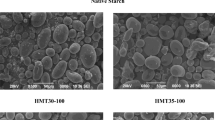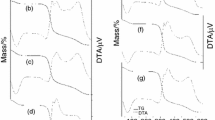Abstract
Organic foods and crops are produced throughout the world under strict controls on growing conditions, so that synthetic chemicals, irradiation or genetic modifications are avoided. Organic starch is extracted following the same rules. Heat–moisture treatment (HMT) on starch is a physical method considered to be natural: it consists of heating starch at a temperature above its gelatinisation point with insufficient moisture (<35 %) to cause gelatinisation. Samples of organic cassava starch (with 12.8 % moisture) were dried in an oven with forced air circulation at 50 °C for 48 h and, immediately, distilled water was added to each sample until it reached the ratios of 10, 20, and 30 %, respectively. The samples were transferred into 100 mL pressure flasks, sealed tightly with a cap, and maintained in an autoclave for 60 min at 120 °C. The flasks were opened and the samples were kept in a desiccator containing anhydrous calcium chloride up to constant mass. The effects of HMT were studied using the following techniques: thermogravimetry and derivative thermogravimetry (TG/DTG), differential scanning calorimetry (DSC), rapid viscoamylographic analysis (RVA), reflectance photocolorimetry, atomic force microscopy (NC-AFM) and X-ray diffractometry (XRD). Rheological properties such as the pasting temperature (RVA) and the peak temperature (DSC) increased, while gelatinisation enthalpy ∆H (DSC) decreased. The average diameters of the granules showed no significant changes, while the degree of relative crystallinity decreased.





Similar content being viewed by others
References
Costa FJOG, Almeida RR, Lacerda LG, Carvalho-Filho MAS, Bannach G, Schnitzler E. Thermoanalytical study of native cassava starch and treated with hydrogen peroxide. Aliment e Nutrição. 2011;22:7–15.
Leivas CL, Costa FJOG, Almeida RR, Freitas RJS, Stertz SC, Schnitzler E. Structural characteristics, physico-chemical, thermal and pasting properties of potato (Solanum tuberosum L.) flour: study of different cultivars and granulometries. J Therm Anal Calorim. 2012. doi:10.1007/s10973-012-2395-2.
Lacerda LG, Carvalho Filho MAS, Demiate IM, Bannach G, Ionashiro M, Schnitzler E. Thermal behavior of corn starch granules under action of fungal a-amylase. J Therm Anal Calorim. 2008;93:445–9.
Colman TAD, Demiate IM, Schnitzler E. The effect of microwave radiation on some thermal, rheological and structural properties of cassava starch. J Therm Anal Calorim. 2012;. doi:10.1007/s10973-012-2866-5.
Winter CK, Davis S. Organic foods. J Food Sci. 2006;71:117–24.
Magkos F, Arvaniti F, Zampelas A. Organic food: buying more safety or juste peace of mind? A critical review of the literature. Crit Rev Food Sci Nutr. 2006;46:23–56.
Singh J, Kaur L, McCarthy OJ. Factors influencing the physico-chemical, morphological, thermal and rheological properties of some chemically modified starches for food applications: a review. Food Hydrocol. 2007;21:1–22.
Matsuguma LS, Lacerda LG, Schnitzler E, Carvalho-Filho MAS, Franco CML, Demiate IM. Characterization of native and oxidized starches of two varieties of Peruvian carrot (Acacia xanthorriza B.) from two production areas of Paraná state, Brazil. Braz Arch Biol Technol. 2009;52:701–13.
Garrido LH, Schnitzler E, Zortéa MEB, Thaís de Souza Rocha TS, Demiate IM. Physicochemical properties of cassava starch oxidized by sodium hypochlorite. J Food Sci Technol. 2012;. doi:10.1007/s13197-012-0794-9.
Beninca C, Colman TAD, Lacerda LG, Carvalho-Filho MAS, Demiate IM, Bannach G, Schnitzler E. Thermal, rheological, and structural behaviors of natural and modified cassava starch granules, with sodium hypochlorite solutions. J Therm Anal Calorim. 2012;. doi:10.1007/s10973-012-2592-z.
Kweon M, Haynes L, Slade L, Levine H. The effect of heat and moisture treatments on enzyme digestibility of AeWx, Aewx and aeWx corn starches. J Therm Anal Calorim. 2000;59:571–86.
Zavareze ER. Dias ARG. Impact of heat–moisture treatment and annealing in starches: a review. Carbohydr Polym. 2011;83:317–28.
Watcharatewinkul Y, Puttanlek C, Rungsardthong V, Uttapap D. Pasting properties of a heat–moisture treated canna starch in relation to its structural characteristics. Carbohydr Polym. 2009;75:505–11.
Chung H-J, Cho A, Lim S-T. Effect of heat–moisture treatment for utilization of germinated brown rice in wheat noodle. LWT Food Sci Technol. 2012;47:342–7.
Balasubramanian S, Sharma R, Kaur J, Bhardwaj N. Characterization of modified pearl millet (Pennisetum typhoides) starch. J Food Sci Technol. 2011;. doi:10.1007/s13197-011-0490-1.
Takahasi T, Miura M, Ohisa N, Mori K, Kobayashi S. Heat treatments of milled rice and properties of the flours. Cereal Chem. 2005;82:228–32.
Lorlowhkarn K, Naivikul O. Modification of rice flour by heat–moisture treatment (HMT) to produce rice noodles. Kasetsart J. 2006;40:135–43.
Shih F, King J, Daigle K, An H-J, Ali R. Physicochemical properties of rice starches modified by hydrothermal treatments. Cereal Chem. 2007;84:527–31.
Juszczak L, Fortuna T, Krok F. Non-contact atomic force microscopy of starch granules surface. Part I. Potato and tapioca starches. Starch/Stärke. 2008;55:1–7.
Juszczak L, Fortuna T, Krok F. Non-contact atomic force microscopy of starch granules surface. Part II. Selected cereal starches. Starch/Stärke. 2008;55:8–18.
Colman TAD, Bicudo SCW, Lacerda LG, Carvalho-Filho MAS, Demiate IM, Bannach G, Schnitzler E. Characterization of wheat starch by thermoanalytical, rheological and atomic force microscopy techniques. Braz J Therm Anal. 2012;1:62–5.
Zhang L, Xie W, Zhao X, Liu Y, Gao W. Study on the morphology, crystalline structure and thermal properties of yellow ginger starch acetates with different degrees of substitution. Thermochim Acta. 2009;495:57–62.
Zavareze ER, Storck CR, Castro LAS, Schirmer MA, Dias ARG. Effect of heat–moisture treatment on rice starch of varying amylose content. Food Chem. 2010;121:358–65.
Miao M, Zhang T, Jiang B. Characterisations of kabuli and desi chickpea starches cultivated in China. Food Chem. 2009;113:1025–32.
Falade KO, Kolawole TA. Effect of γ-irradiation on colour, functional and physicochemical properties of pearl millet [Pennisetum glaucum (L) R. Br.] cultivars. Food Bioprocess Technol. 2012;. doi:10.1007/s11947-012-0981-8.
Gunaratne A, Hoover R. Effect of heat–moisture treatment on the structure and physicochemical properties of tuber and root starches. Carbohydr Polym. 2002;49:425–37.
Acknowledgements
The financial resources for this study were provided by the Fundação Araucária, PR, Brazil, the FINEP-Brazil, CAPES-Brazil and the CNPq-Brazil, whom the authors gratefully acknowledge.
Author information
Authors and Affiliations
Corresponding author
Rights and permissions
About this article
Cite this article
Andrade, M.M.P., de Oliveira, C.S., Colman, T.A.D. et al. Effects of heat–moisture treatment on organic cassava starch. J Therm Anal Calorim 115, 2115–2122 (2014). https://doi.org/10.1007/s10973-013-3159-3
Received:
Accepted:
Published:
Issue Date:
DOI: https://doi.org/10.1007/s10973-013-3159-3




